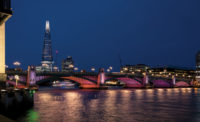Jimmy Page bought his much-loved Les Paul Custom at one of Denmark Street’s guitar shops. The Rolling Stones recorded their first album of blues covers on the block at Regent Sound, around the same time David Bowie recorded a demo at Central Sound before becoming a regular at Gioconda, the café hangout for musicians. This short run of Victorian buildings on the edge of London’s Soho neighborhood, now refurbished and ready for a new life, is where the city’s popular-music community has long gathered to record songs, buy instruments, and exchange gossip.
If Carnaby Street, at the other end of Oxford Street, was where bands in the 1960s bought clothes and built their image, Denmark Street was about business. The publishers Mills Music rejected Paul Simon’s Sounds of Silence, compelling him to record it himself rather than offering it to another performer, and later employed Elton John as an office boy. The Sex Pistols lived and rehearsed on the street. Countless young bands cut their teeth at the 12 Bar, the street’s main performance venue.

Numerous instrument shops have remained along London’s famed Denmark Street (above), now complemented by new buildings (top). Photo © Tim Soar, click to enlarge.
Denmark Street’s resurrection once looked unlikely. In the 1990s, when the adjacent Tottenham Court Road was earmarked for expansion to accommodate the cross-city Elizabeth Line metro link, the street seemed doomed. Previous owners had explored tower schemes with SOM and Norman Foster, but couldn’t make them work financially—and faced opposition from Camden Council, the local planning authority. Then, in 1994, the developer Laurence Kirschel—a longtime Soho property owner and fan of its distinctive culture—began buying up parcels on the street with an eye toward preserving its character.
By 2009, Kirschel had assembled a 62,850-square-foot site, a portion of which he handed over to the city for construction of the Elizabeth Line. He brought in Orms, an architecture practice known for its stylish refurbishments of noted London buildings and, encouraged by Camden Council, began renovating his 19 properties. He maintained the street’s focus on music: seven established music shops have remained, and new ones, like the first-ever retail outlet for music electronics manufacturer Roland, have joined. Scattered across the site, on the upper floors of 16 of these buildings, are the 55 rooms of a hotel. Called Chateau Denmark, it offers conventional short stays but also longer leases, in rooms with designs that riff on the rock pedigree of the street.
This is not simply a case of feeding up a cultural past to wealthy hotel guests. What is remarkable about Orms’s work for Kirschel are the four performance venues that have been carved out belowground, without disrupting the buildings above. Spanning the basements of several buildings is a venue for an audience of 100. A building on the corner houses a 150-person venue on the ground floor with a nightclub in the basement. The old 12 Bar has been refurbished, including a converted 17th-century blacksmith’s forge that has been incorporated at the rear; renamed the Lower Third after Bowie’s original backup band, it now has an increased capacity of 350 in the basement. The largest addition is HERE, a 2,000-person subterranean venue to the north of the street.

Hanks Electric Guitars, a mainstay of Denmark Street, has been joined by a number of new shops and venues. Photo © Tim Soar
Although there is a recording studio on the south side of the street, run by the British Phonographic Industry, Denmark Street has shifted emphasis from music business to performance—but that’s not necessarily a problem. In a country where the government felt the need, in 2019, to set up a commission to examine why its music venues were closing, these new ones are much needed.
Ironically, this refurbishment has happened without Londoners’ knowing much about it. The focus has been on the two new buildings to the north of Denmark Street, the larger dubbed the Now Building and the smaller Now Trending. These are admittedly pure bling, but at the end of the gauche and highly commercial Oxford Street, this feels appropriate. The two four-story buildings, also designed by Orms, are clad in golden-hued titanium-coated stainless steel. From noon to midnight, the walls of the Now Building retract to reveal 24,300 square feet of LED screens inside, offering retailers, manufacturers, or promoters the opportunity to get in front of the estimated 400,000 people who pass the site each day. The revenue generated by these buildings in turn subsidizes the lower rents offered on Denmark Street itself. The way this complex, encompassing a hotel, retail, performance, and advertising, operates together is impressive, with its collective name, the overly clever Outernet, the only duff note.
The joke goes that nostalgia is not what it used to be, but London may be passing through a golden age of it. Moved by a sentimental yearning for the past, the Outernet provides an intoxicating and distinctively London experience. One emerges from the extended underground station to behold an indoor Piccadilly Circus of light and commerce before passing down an old-fashioned alleyway that feeds into Denmark Street. There one has a drink at the Lower Third and then disappears underground for a live gig at the roomy, state-of-the-art HERE. Certain elements of the Outernet—the hotel rooms and the interior of the Lower Third, for example—may have overdone the rock history, but the complex is an astonishing offering for a city whose live music scene is still recovering from Covid-19.





